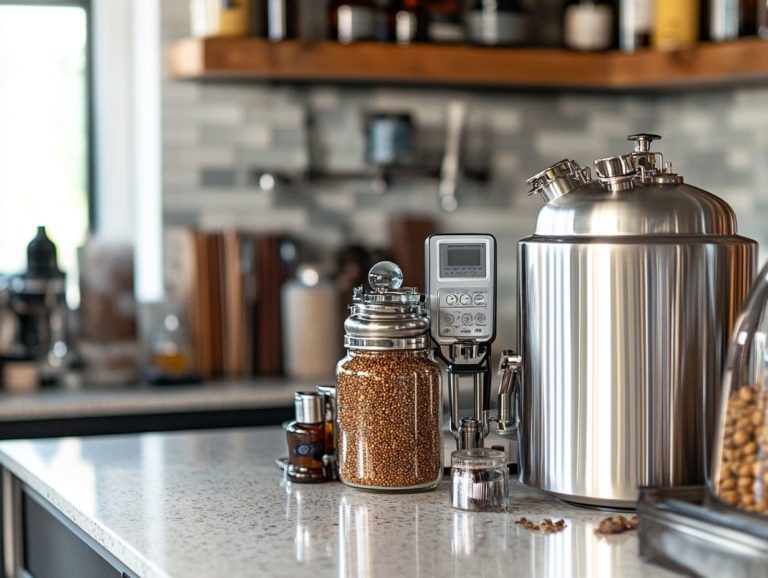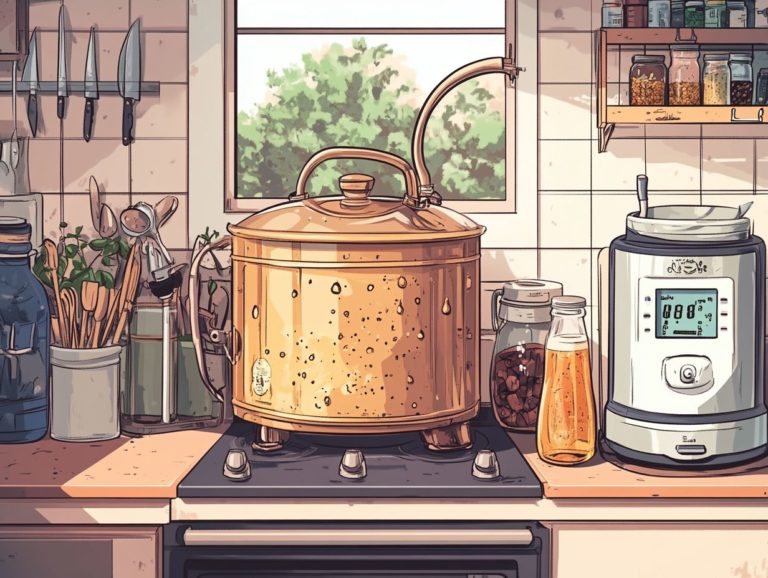What Are the Different Types of Kegs?
Choosing the right beer keg can truly elevate your gathering, whether you re hosting a casual backyard barbecue or planning a big party!
With a range of keg types and sizes at your disposal, understanding the differences is crucial for selecting the perfect one tailored to your needs. From full-size kegs to mini options, each comes with unique characteristics designed to cater to distinct occasions and personal preferences, including popular brands like Heineken, Pepsi, and Coke.
Let s dive into the exciting world of beer kegs! We will also discuss the expected number of pints and cans per keg.
Contents
Key Takeaways:
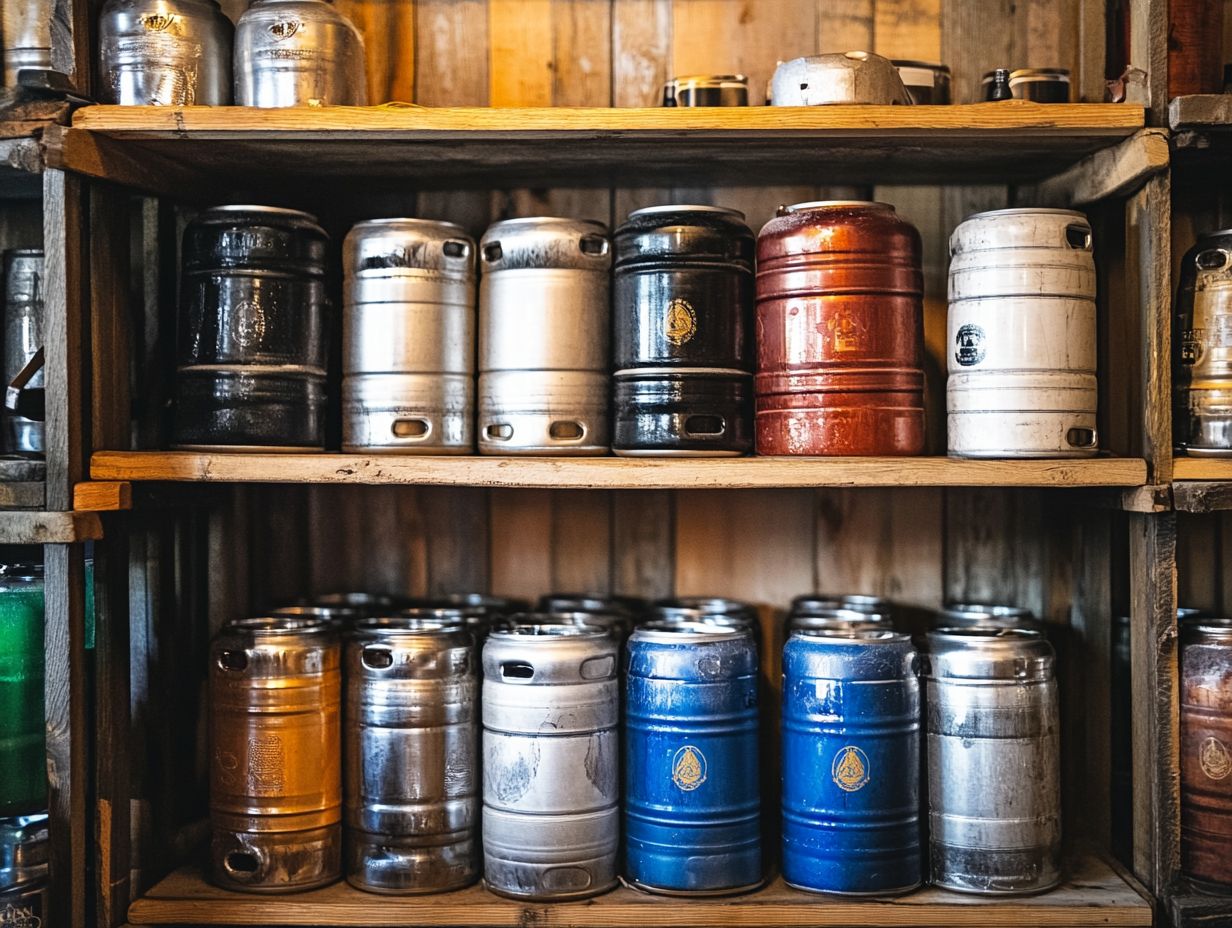
- Discover diverse keg types like full-size, quarter barrel, and mini!
- Learn about the most common keg sizes tailored for your needs!
- Keg sizes differ in volume, weight, dimensions, and cost, so choose the right one based on your needs and preferences. This includes considering options like the 50 Litre Keg for larger events!
What are the Different Types of Kegs?
Understanding the various types of kegs like the Full-Size Keg, Quarter Barrel Keg, Slim Quarter Keg, Half Barrel Keg, Mini Keg, Pony Keg, Sixth Barrel Keg, Beer Ball, and Cornelius Keg is crucial for anyone looking to elevate their beer dispensing experience.
Each keg type boasts its own distinct features, including capacity and dimensions, tailored to meet different needs, whether for personal enjoyment or commercial use. By familiarizing yourself with these keg options, you ll empower yourself to make informed choices that significantly enhance your beer dispensing experience. Whether you’re a casual drinker or a homebrewer, understanding keg sizes and types of kegs will help you make the best choice.
1. Full-Size Keg
The Full-Size Keg, commonly known as a Half Barrel Keg, is the quintessential choice you ll encounter in commercial settings, boasting a capacity of approximately 15.5 gallons or 58.67 liters of beer. This size is often used by famous brands like Anheuser-Busch and Guinness.
This impressive size translates to around 165 servings of 12-ounce pints, making it the perfect option for large gatherings and events. Not only does it hold a substantial amount of beer, but it also ensures that your guests have a steady supply of drinks, minimizing the hassle of frequent keg changes.
Traditionally, this keg type serves a wide range of beers, from crowd-pleasing lagers to rich ales and hearty stouts, giving you the flexibility to curate diverse selections that cater to various palates. Its sturdy design and standard size make transportation and storage a breeze, positioning it as the go-to choice for everything from outdoor festivities to bustling pub environments. It’s also worth noting its compatibility with various keg couplers for different beer styles.
2. Quarter Barrel Keg
The Quarter Barrel Keg, affectionately known as a Pony Keg, presents a sophisticated yet compact solution, holding around 7.75 gallons or 29.33 liters making it an exceptional choice for smaller gatherings and events.
With the capacity to dispense approximately 82 pints or 124 cans, this keg size strikes the perfect balance between manageability and practicality. It allows you to offer ample refreshments without cluttering your space or straining your storage options.
Whether it’s a backyard barbecue, an intimate celebration, or a small party, the Quarter Barrel Keg adapts seamlessly to various occasions. It’s versatile enough to accommodate a range of beer styles, from light lagers to hoppy IPAs and smooth stouts, ensuring that every palate is pleased and that your guests can savor a refreshing drink throughout the festivities. This keg type is also popular for serving imported beers like Stella Artois and Newcastle.
In conclusion, understanding the different types of kegs and their sizes can significantly enhance your beer experience. Choose the right keg for your next event, and enjoy the festivities!
3. Slim Quarter Keg
The Slim Quarter Keg presents a slightly taller and narrower profile compared to the standard Quarter Barrel, offering similar capacity while optimizing your storage space ideal for those who might be working with limited room.
This design appeals to home brewers and others who want to expand their drink options without relinquishing valuable space in their beer refrigerators. One of the standout aspects of the Slim Quarter Keg is its compatibility with a variety of keg couplers, enabling you to effortlessly tap into different beer styles. This enhances the versatility of your gatherings. It is also a preferred choice for those looking into soda keg options for non-alcoholic beverages.
Its sleek silhouette ensures a snug fit within smaller beer refrigerators, eliminating the struggle of accommodating larger kegs while still providing an ample supply of refreshing beer on tap. Imagine the fun at your next gathering with a Slim Quarter Keg ready to serve!
This makes the Slim Quarter Keg a smart choice for anyone looking to elevate their entertaining experience.
4. Half Barrel Keg
The Half Barrel Keg is an essential component for any beer refrigerator setup, boasting a capacity of 15.5 gallons or 58.67 liters of beer. This makes it the perfect choice for your parties and large gatherings.
With the ability to serve approximately 165 12-ounce pours, it s no wonder this size is a favorite among hosts who want to ensure a steady supply of beer. When you compare it to other keg sizes, like the Quarter Barrel, which holds only 7.75 gallons, the Half Barrel shines with its double capacity. This means fewer keg changes during your celebrations, allowing you to focus more on enjoying the event rather than worrying about running out of beer.
Thanks to the standard 2-inch coupling used in these kegs, you can expect efficient dispensing that leads to smooth pours with minimal foam an important detail when serving beer to your guests. This blend of efficiency and ample capacity is precisely why the Half Barrel Keg is the go-to choice for both venues and home brewers.
5. Mini Keg
The Mini Keg stands out as a go-to option for casual drinkers, holding 5 liters of beer and perfectly suited for personal use or intimate gatherings. Its compact size allows for effortless storage and transport, making it an ideal choice for those who savor fresh draft beer without the commitment of a full-sized keg.
Its lightweight aluminum or stainless steel construction ensures durability and ease of handling.
With offerings from popular brands like Heineken, Franziskaner, and Pilsner Urquell, Mini Kegs not only enhance your drinking experience but also blend seamlessly into your home setup. Integrating a Mini Keg into your beer refrigerator system is a breeze, ensuring that each pour remains as fresh and enjoyable as the first.
This also makes it a great option for those who prefer the Beverage Journal method for tracking their consumption.
By opting for Mini Kegs, you reduce waste while enjoying greater convenience, providing an excellent solution for anyone looking to elevate their home bar experience.
6. Pony Keg
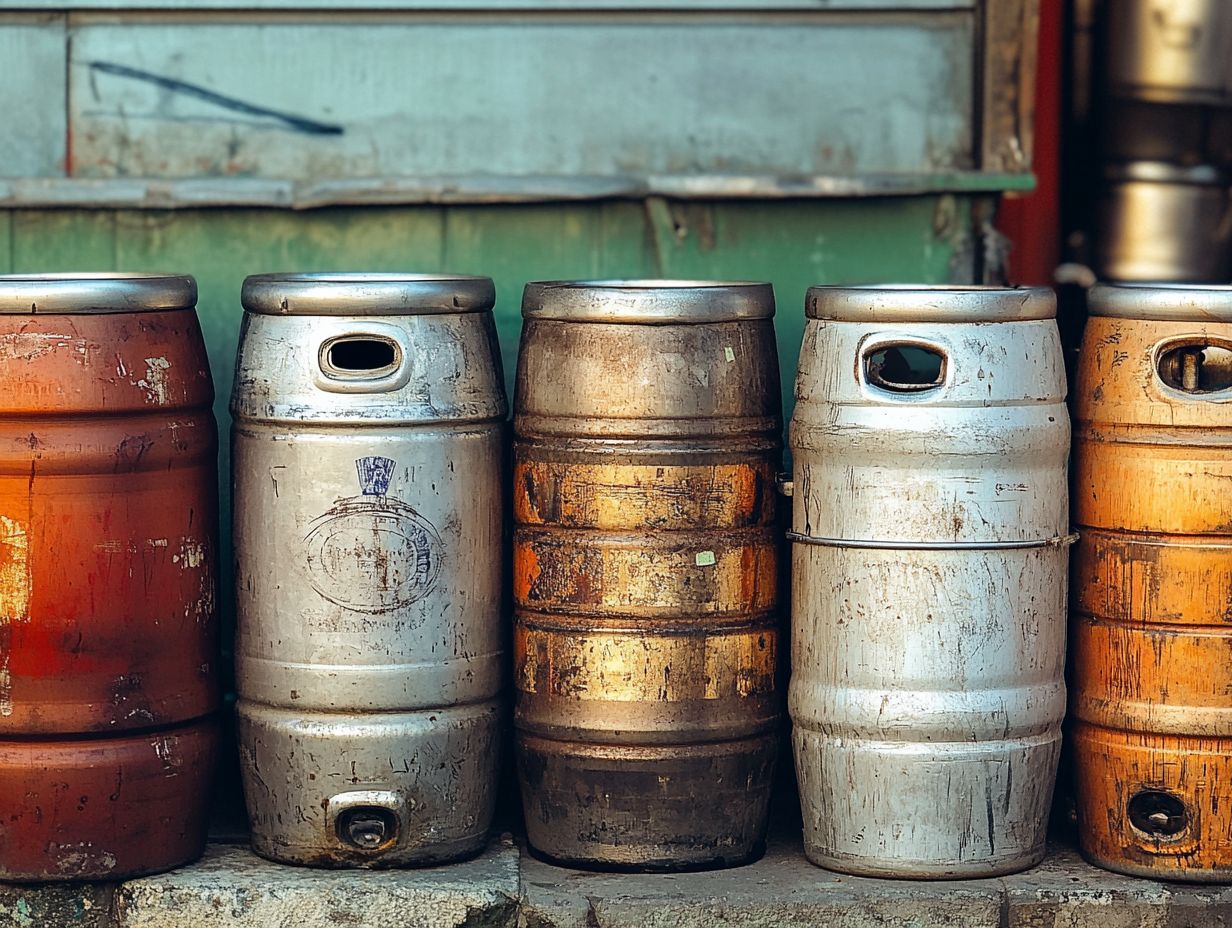
The Pony Keg, often referred to as the Quarter Barrel Keg, holds a convenient 7.75 gallons of beer perfectly balancing capacity and manageability for your gatherings.
This size is ideal for mid-sized events like birthday parties, family reunions, and BBQs, where a larger keg might overwhelm your space, yet a standard party-sized container could leave everyone wanting more.
When you think of the Pony Keg, you’ll likely appreciate its portability and the effortless way it can be tapped and served, offering a fresh draft beer experience without the complications that come with larger options.
Using a Pony Keg allows you to showcase a variety of beer styles, encouraging your guests to sample and explore different flavors throughout the event. This creates a more interactive and enjoyable atmosphere, turning your gathering into a memorable celebration.
Don’t miss out on the chance to impress your guests with freshly tapped beer!
7. Sixth Barrel Keg
The Sixth Barrel Keg has a capacity of 5.16 gallons (approximately 19.5 liters). It’s the perfect option for craft beer enthusiasts who want to explore a variety of brews without the commitment of larger sizes. This keg size is also popular for serving specialty and seasonal brews from brands like Hoegaarden.
Its compact design is practical for gatherings, small parties, or home tastings. This allows you to present an enticing selection of craft beers without overwhelming your guests. The ergonomic structure fits seamlessly into most kegerator setups, ensuring a hassle-free tapping experience while optimizing fridge space.
As a beer lover, you ll appreciate the Sixth Barrel Keg for its portability and freshness. It maintains optimal carbonation and flavor over an impressively extended period.
Incorporating this keg into your home brewing arrangements allows you to efficiently delve into different styles, fostering a richer appreciation for the art of brewing.
8. Cornelius Keg
The Cornelius Keg, often called the Corny Keg, is essential for homebrewers. It accommodates 5 gallons of your finest brew and is designed for optimal beer dispensing and carbonation. This keg type is versatile, as it’s also used for serving craft soda and other carbonated beverages.
Its stainless steel construction ensures durability and rust resistance. Cleaning is a breeze, allowing for repeated use without hassle. With a tightly sealing lid, the keg effectively maintains carbonation over extended periods, ensuring each pour remains fresh and flavorful.
Homebrewers will appreciate its compatibility with various kegerator systems. The Corny Keg fits seamlessly into standard setups, making integration with CO2 regulators effortless. This versatility enhances your brewing experience and offers the convenience of dispensing multiple beer styles from the same system, elevating your home bar.
What Are the Most Common Keg Sizes?
Keg sizes come in a delightful array. Among the most common are the Half Barrel Keg, Quarter Barrel Keg, Slim Quarter Keg, Mini Keg, Sixth Barrel Keg, Cornelius Keg, and the popular 50 Litre Keg.
Each keg type is designed to cater to varying needs and preferences for dispensing and storing beer. There s a perfect option for every occasion, whether you re using a Cornelius Keg or a traditional keg.
1. US Standard Keg Sizes
In the United States, standard keg sizes include the Half Barrel Keg, Quarter Barrel Keg, and Slim Quarter Keg. Each is tailored to meet different preferences for storing and dispensing beer. These kegs are also popular among brands like Anheuser-Busch and Stella Artois.
The Half Barrel Keg, often called the full-size keg, holds 15.5 gallons. It’s the go-to choice for bars and large gatherings where a consistent beer supply is essential.
The Quarter Barrel Keg, known as the Pony Keg , has a capacity of 7.75 gallons. It strikes a balance between size and storage space, making it ideal for smaller parties or intimate venues that demand a respectable amount of beer.
The Slim Quarter Keg also has a capacity of 7.75 gallons but comes in a narrower design. This caters specifically to home users with limited refrigerator space. It’s a popular choice for those using kegerators from brands like Pepsi and Coke.
This diverse range of keg sizes ensures that whether you re running a bustling venue or enjoying a relaxing evening at home, you can easily find the perfect keg to suit your needs.
Don’t miss out on trying these fantastic keg options! Explore your choices today to elevate your home brewing experience!
2. European Keg Sizes
European keg sizes are quite distinct from US standards. The 50-litre keg stands out as a popular choice, complemented by various Mini Kegs that appeal to casual beer enthusiasts. Brands like Guinness, Newcastle, and Hoegaarden often use these kegs.
The 50-litre keg is a favorite in pubs and bars, thanks to its substantial capacity. This allows establishments to serve a remarkable volume of beer without the hassle of frequent replacements. In contrast, the United States typically employs a variety of keg sizes, prominently featuring the half-barrel keg, which holds 15.5 gallons, or approximately 58.67 litres.
This difference in volume showcases contrasting beer dispensing practices. Europeans often embrace larger, shared servings in social settings, while Americans tend to prefer smaller, more personalized selections.
By understanding these nuances, you ll discover more about the rich beer cultures that flourish on both sides of the Atlantic.
3. UK Keg Sizes
In the UK, you ll typically encounter keg sizes like the 30-litre keg and the 20-litre keg. Both are staples in pubs and restaurants serving a diverse range of beers. Import kegs are also common for international brands like Heineken and Stella Artois.
These sizes are favored because they perfectly balance volume and manageability. This allows you to meet varying customer demands without generating excessive waste. The 30-litre keg is a fantastic choice for high-traffic venues, ensuring you have enough supply to keep up with the bustling crowd during peak hours.
On the other hand, the 20-litre keg offers great versatility for smaller bars that prefer to rotate their beer selections more frequently.
Many establishments invest in keg systems designed specifically for these sizes. This ensures efficient dispensing while maintaining the quality of the beer from keg to glass.
What Are the Differences Between Keg Sizes?
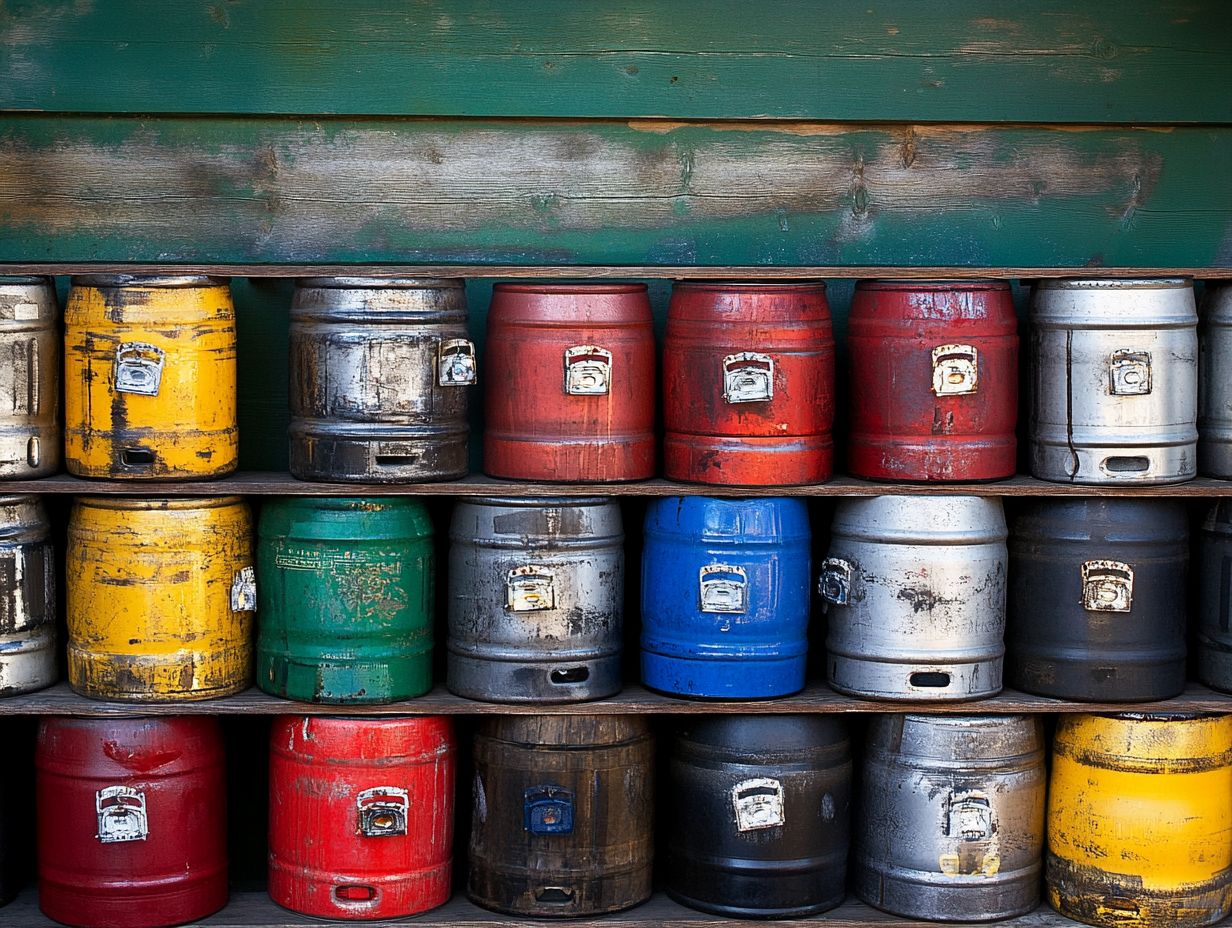
The distinctions between keg sizes primarily hinge on factors such as volume, weight, dimensions, and cost. These elements ultimately determine the number of pints or cans that can be served from each type of keg, whether it’s an Aluminium or Stainless Steel keg.
1. Volume
Volume plays a pivotal role when you’re comparing different keg sizes. It directly influences the total amount of beer available for serving, whether you measure in pints or cans. Publications like Beverage Journal often feature articles on how to optimize beer dispense based on keg size.
Take, for example, a standard half-barrel keg, which is the go-to choice for bars and restaurants. It holds approximately 15.5 gallons of beer, translating to around 165 12-ounce pints or 120 cans. This makes it the perfect option for larger gatherings or events where you want to keep the good times flowing.
If you re hosting a smaller get-together, a quarter-barrel keg might be more your speed. This size contains about 7.75 gallons, yielding roughly 82 pints or 62 cans. If you re looking for something even more compact, a sixth-barrel keg provides about 5.16 gallons, offering around 55 pints or 40 cans.
By grasping these distinctions, you can effectively plan for your consumption needs and choose the keg size that best aligns with your event.
2. Weight
The weight of a keg can vary dramatically based on its size and the type of beer it holds. This variation affects how you handle and transport it. For instance, a Beer Ball weighs less than a traditional keg, making it easier to manage.
A standard full-size keg might tip the scales at around 160 pounds, while smaller quarter or sixth kegs are much lighter. This makes them more manageable and easier to load for distribution. This weight difference doesn t just impact transportation; it also plays a pivotal role in selecting the right dispensing equipment.
Heavier kegs may require more robust features in your dispensing systems to ensure stability and support. Conversely, lighter options offer greater flexibility in placement and handling.
Therefore, it s essential for you to consider the weight of the kegs when choosing your equipment.
Dimensions
The dimensions of kegs can vary significantly, impacting how well they fit in your kegerator and the overall space you need for storage. Whether you’re using a Corny Keg or a Sanke keg, understanding these variations is essential.
These variations are important for both enthusiasts and businesses, as selecting the right keg size can optimize your available space and ensure your equipment operates smoothly. For example, a standard sized sixth barrel keg, measuring about 16 inches in height and 9.25 inches in diameter, typically fits snugly in most compact kegerators. In contrast, a full-size keg, usually around 23.3 inches tall and 16 inches in diameter, demands a bit more room.
By recognizing the slim profile of a Cornelius keg versus the more substantial dimensions of a Sanke keg, you can make informed decisions that lead to efficient storage solutions. This maximizes functionality and enhances your beer-drinking experience.
Cost
Cost is a crucial factor to keep in mind when selecting keg sizes, as it can fluctuate based on the type of keg and the beer it holds.
The pricing landscape is shaped by various elements, including the brand of the beer, its quality, and even the brewery’s location. High-quality craft beers typically command a higher price, influencing both consumer preferences and the financial performance of businesses.
For larger kegs like half-barrels, you ll often find a lower cost per pint compared to their smaller counterparts. This means it’s wise to evaluate your customer flow and drinking habits before making a purchase.
Watch for promotional periods or seasonal offerings, as these can cause fluctuations in keg prices. Being mindful of these economic impacts will help you make selections that maximize both enjoyment and value.
Which Keg Size is Right for You?
Selecting the appropriate keg size requires careful consideration of several factors, including your unique needs, the nature of the event, available storage space, and the number of guests you intend to serve.
It is crucial for you to evaluate the keg sizes that best match your beer dispensing preferences, ensuring a seamless experience for both you and your guests.
Frequently Asked Questions
What Are the Different Types of Kegs?
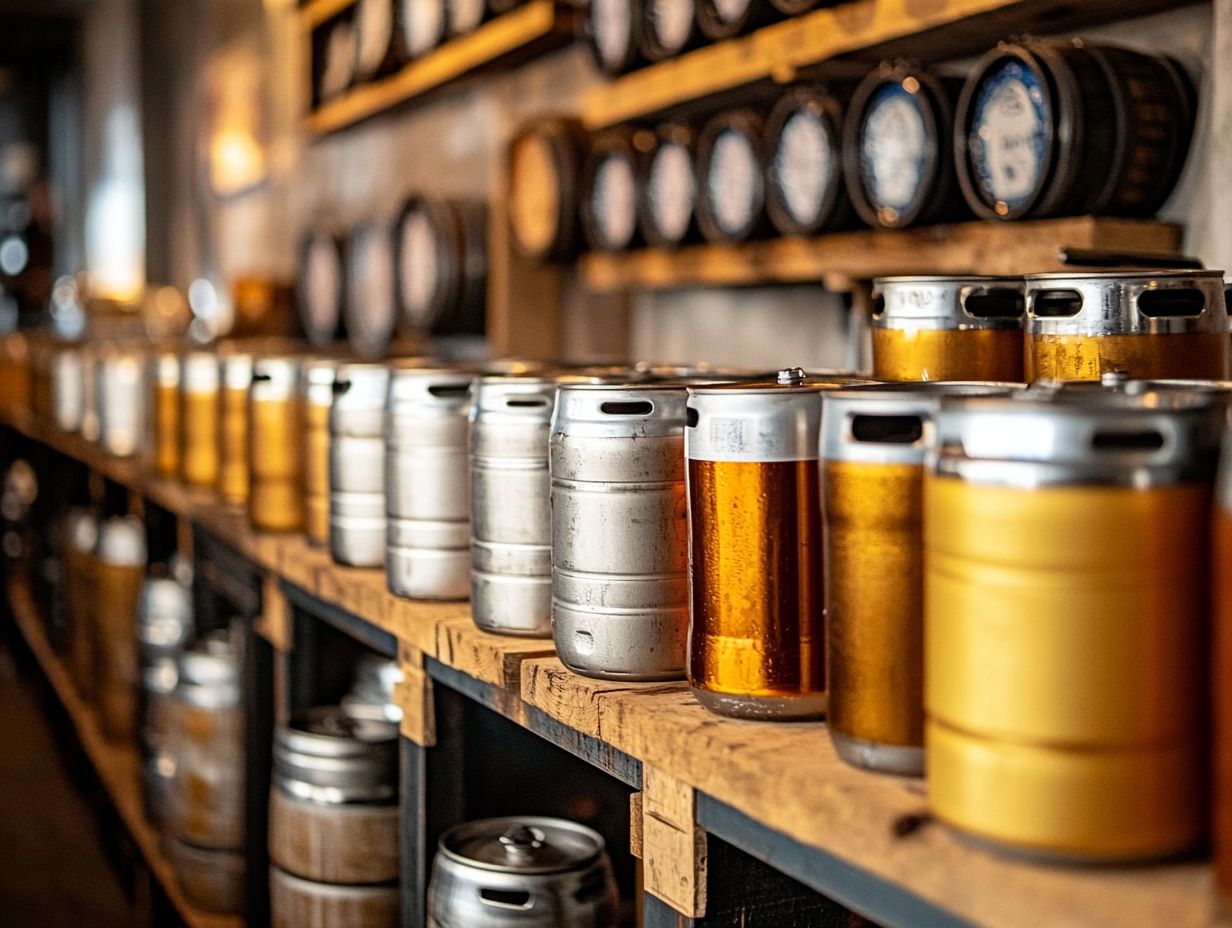
- Traditional
- Pony
- Slim
- Quarter Barrel
- Half Barrel
- Mini Kegs
Each type is designed to hold a specific amount of liquid and has unique features.
What is a Traditional Keg?
A traditional keg, also known as a full-size keg or barrel, is the most common type of keg. It can hold 15.5 gallons or 165 12-ounce cans of beer. This type of keg is used in bars and restaurants and requires a tap system for dispensing.
What is a Pony Keg?
A pony keg, also called a stubby or quarter barrel keg, is half the size of a traditional keg and can hold 7.75 gallons or 82 12-ounce cans of beer. It is often used for smaller events or gatherings and can be easily transported by one person.
What is a Slim Keg?
A slim keg, also known as a tall quarter or slim quarter keg, is similar in size to a pony keg but has a taller and narrower design. It can hold the same amount of liquid as a pony keg but is more space-efficient. This type of keg is commonly used in home kegerators.
What is a Quarter Barrel Keg?
A quarter barrel keg, also known as a barrel keg or tall quarter keg, can hold 7.75 gallons or 82 12-ounce cans of beer. It has a similar size and shape to a pony keg but is taller and narrower. This type of keg is often used in home kegerators and small events.
What is a Half Barrel Keg?
A half barrel keg, also known as a full-size keg or standard keg, is the same size as a traditional keg and can hold 15.5 gallons or 165 12-ounce cans of beer. It is commonly used in bars and restaurants and requires a tap system for dispensing.
Explore our selection of kegs to find the perfect fit for your needs!
What are Mini Kegs?
Mini Kegs are smaller, portable kegs designed for casual use. They re perfect for home users and loved for their easy-to-use taps.
Mini kegs, also called Bubba kegs or Corny kegs, hold 5 liters about 14 cans of beer. They are fantastic for home brewing and small gatherings.
You can also use similar keg systems for drinks like Coke and Pepsi. Other keg sizes include Sixth Barrel, Quarter Barrel, Slim Quarter, Half Barrel, and 50 Litre Kegs.
Made from Aluminum or Stainless Steel, mini kegs don t need a tap system and fit easily in your refrigerator. In some areas, they re known as Beer Balls.
Popular brands like Heineken, Stella Artois, and Newcastle offer mini kegs. Don’t miss out on the fun grab a mini keg for your next party!




